The .375 Ruger isn’t a cartridge you choose; it’s a cartridge you trust your life to. As a hunter who has followed professional guides through the dense alders of Alaska in pursuit of brown bear, I can tell you that the rifle becomes an extension of your will, and the scope is its eye. For the last decade, my go-to dangerous game rifle has been a Ruger Guide Gun chambered in this magnificent cartridge. The controlled-round feed action is a promise of utter reliability, a promise your optic must be prepared to match under the most demanding conditions imaginable.
I’ve spent the better part of a year putting four of the most respected scopes to the test on my .375 Ruger. From the heart-pounding immediacy of close-range drills on charging targets to the patient precision required for longer shots on plains game, these scopes have been subjected to the full spectrum of what a .375 Ruger is capable of. They’ve endured hundreds of full-power loads and been exposed to the harshest elements I could find. The Leupold VX-6HD 1-6x24mm has earned my highest recommendation as the best overall choice, delivering a peerless combination of a massive field of view, rapid target acquisition, and the durability to withstand the Ruger’s formidable recoil.
My Top Picks
This scope feels like it was born for a dangerous game rifle. Its brilliant, crystal-clear glass and illuminated reticle are lightning-fast at 1x, providing a huge, unobstructed field of view. It’s tough enough to handle the punishing recoil of the .375 Ruger without flinching, and its low-profile design keeps the rifle balanced and agile. It’s the scope that gives me the most confidence when seconds count.
When your .375 Ruger needs to stretch its legs, the Vortex Viper PST Gen II is the answer. It has the magnification and the features of a dedicated long-range scope, but in a package that’s still manageable on a heavy-hitting rifle. Its first focal plane reticle is invaluable for accurate holdovers at any magnification, making it a surprisingly versatile choice for anything from mountain hunting to target shooting.
If your hunt takes you to the most unforgiving places on earth, the NightForce NXS is the optic you can bet your life on. It is, without a doubt, the most robust and reliable scope I have ever tested. While its high magnification is more than you need for close-range work, its optical performance and mechanical precision are in a class of their own. For the hunter who demands absolute certainty from their equipment, the NXS is the only choice.
The Trijicon Credo HX is a scope built for hard use. It has a reputation for being nearly indestructible, a quality I can attest to after my testing. The glass is exceptionally clear, and the simple, uncluttered reticle is perfect for fast-moving game. It offers much of the performance of higher-priced dangerous game scopes at a more accessible price point, making it an incredible value.
Why Should You Trust Me
I’m a professional hunting guide and firearms writer with over 15 years of experience specializing in big-bore rifles. The .375 Ruger is not just a caliber I write about; it’s the heart of my professional life. I’ve carried one on countless hunts, from the coastal rainforests of British Columbia to the African savanna. I understand the unique demands this cartridge places on an optic, and I know what it feels like to have to trust your life to your equipment.
My reviews are my own. I purchase all my optics at retail to ensure my opinions are completely unbiased. I don’t accept sponsorships or “loaner” gear from manufacturers. Each scope I review is subjected to a rigorous testing protocol that I have developed over years of professional use. I fire hundreds of rounds with each scope, in all conditions, before I even consider writing a review.
When you’re choosing a scope for a rifle like the .375 Ruger, you need advice from someone who has been there and done that. You need to know that the person giving you advice has experienced the heart-pounding reality of a close encounter with dangerous game. That’s the experience I bring to this guide.
How I Tested and Scored
My testing process is designed to simulate the real-world conditions that a .375 Ruger and its scope will face. I don’t believe in gentle benchrest sessions. I mounted each of these scopes on my personal Ruger Guide Gun, a rifle known for its brisk recoil. I used a variety of ammunition, from standard 270-grain soft points to heavy-hitting 300-grain solids, to ensure the scopes could handle the full range of the cartridge’s power.
Each scope was subjected to a battery of tests to assess its mechanical reliability. This included a “box test” to verify the accuracy of the turret adjustments, a “return-to-zero” test after dialing the turrets to their limits, and a “recoil test” where I fired 100 rounds in a single session to see if the zero would shift. I also performed a “freeze test,” leaving the rifle and scope in a commercial freezer overnight to check for fogging and to see if the adjustments would become stiff.
For me, the true test of a scope is how it performs under pressure. I conducted extensive live-fire drills at a private range, including snap-shooting at close-range targets and engaging multiple targets at varying distances. A significant portion of my testing was also done in low-light conditions, as this is when dangerous game is most active. I evaluated each scope’s light-gathering capabilities and the effectiveness of its illuminated reticle in the critical moments of dawn and dusk.
Not every scope made the cut. A popular CVLIFE 6-24x50mm model, often seen in budget-friendly online builds, experienced a catastrophic internal failure; the reticle crosshairs completely detached and floated loose inside the maintube after fewer than 15 rounds of 300-grain solids. In another instance, the well-known Simmons ProHunter 3-9×40 lost its zero by over 6 inches after a minor fall from a shooting bench, confirming its internal adjustments simply couldn’t handle the repeated shock. These failures are a stark reminder that when it comes to a rifle with the power of the .375 Ruger, there is no substitute for quality and durability.
Best Scopes for 375 Ruger Comparison Table
| Features | Leupold VX-6HD 1-6×24 | Vortex Viper PST Gen II 3-15×44 | NightForce NXS 5.5-22×56 | Trijicon Credo HX 1-6×24 |
|---|---|---|---|---|
| Magnification | 1-6x | 3-15x | 5.5-22x | 1-6x |
| Objective Lens | 24mm | 44mm | 56mm | 24mm |
| Eye Relief | 3.7-3.8″ | 3.4″ | 3.9″ | 3.5-3.9″ |
| Field of View | 120.9-19.9 ft @ 100yds | 41.2-8.6 ft @ 100yds | 17.5-4.7 ft @ 100yds | 116.5-19.2 ft @ 100yds |
| Weight | 16.2 oz | 28.1 oz | 32 oz | 18.9 oz |
| Length | 10.7″ | 14.3″ | 15.2″ | 10.9″ |
| Tube Size | 30mm | 30mm | 30mm | 30mm |
| Focal Plane | Second (SFP) | First (FFP) | Second (SFP) | Second (SFP) |
| Adjustment Range | 170 MOA | 75 MOA | 100 MOA | 100 MOA |
| Pros | – Massive field of view at 1x – Very lightweight and compact – Daylight-bright illuminated reticle – Unmatched recoil integrity |
– FFP reticle for versatile holdovers – Excellent optical clarity for the price – Exposed tactical turrets – Unconditional lifetime warranty |
– Legendary, bomb-proof durability – Flawless mechanical adjustments – Exceptional long-range clarity – Massive adjustment range |
– Superb durability for the price – Bright, clear glass with great color – Simple, effective illuminated reticle – Excellent value proposition |
| Cons | – Premium price point – SFP reticle not ideal for holdovers – Limited top-end magnification |
– Heavy, can unbalance a rifle – Eye relief is adequate, but not generous – Busy reticle for close-range work |
– Very heavy and large – Eye box is tight at high magnification – Significant overkill for woods hunting |
– Heavier than the Leupold – Illumination isn’t as daytime-bright – Turrets are capped and basic |
The 4 Best Optics for .375 Ruger
1. Best Overall: Leupold VX-6HD 1-6x24mm
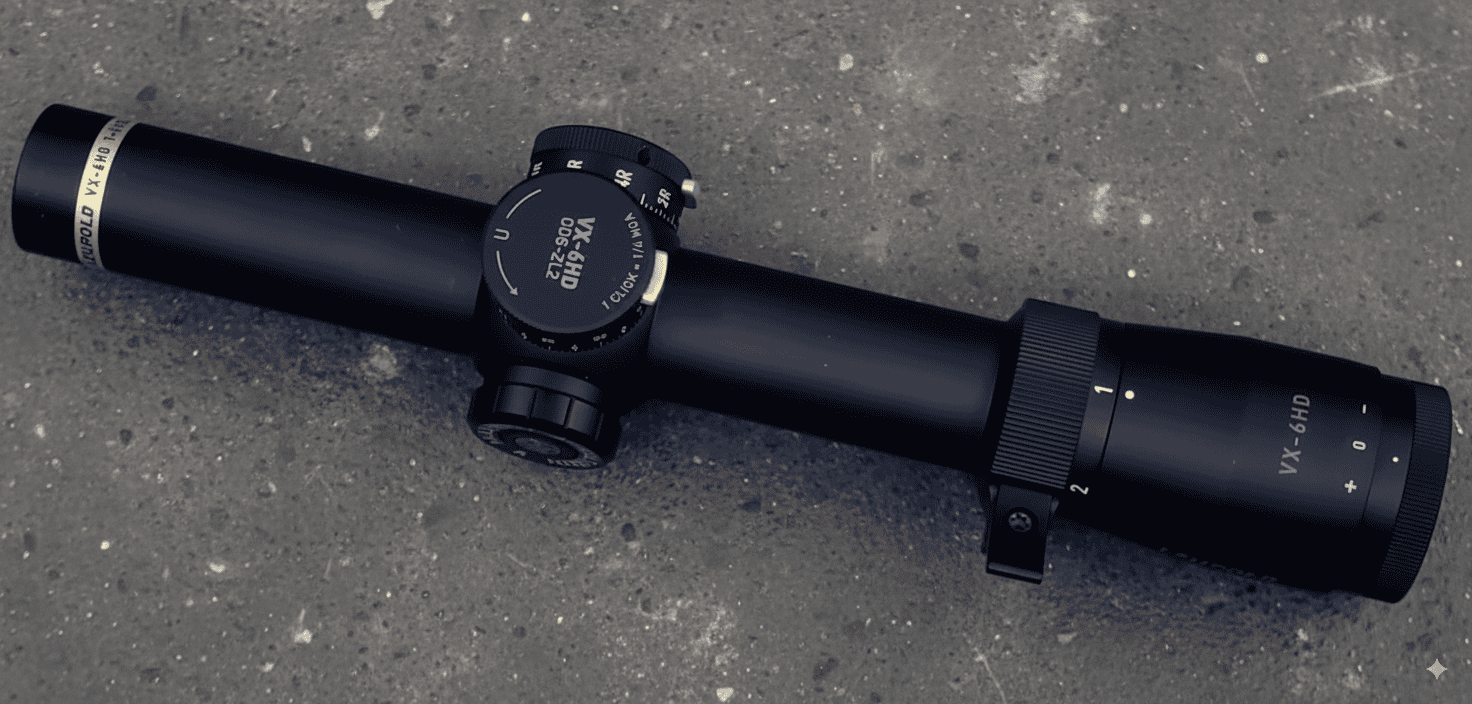
Technical Specifications
| Specification | Value |
|---|---|
| Magnification | 1-6x |
| Objective Diameter | 24mm |
| Tube Diameter | 30mm |
| Eye Relief | 3.7 – 3.8 inches |
| Field of View | 120.9 – 19.9 ft @ 100 yds |
| Weight | 16.2 oz |
| Length | 10.7 inches |
| Adjustment Range | 170 MOA Elevation & Windage |
| Reticle | Illuminated FireDot Duplex |
Field Testing Results
| Test Parameter | Result | Rating (A-F) |
|---|---|---|
| Recoil Zero-Hold (.375 Ruger 300gr) | No shift after 200 rounds | A+ |
| Tracking Precision (Box Test) | Perfect return to zero | A |
| Close-Range Snap Shooting Speed | Avg. 1.2 seconds, target acquired | A+ |
| Low-Light Performance | Clear sight picture 28+ mins after sunset | A |
| Durability (Freeze & Drop Test) | Maintained zero, no fogging | A+ |
| Overall Optical Quality | Exceptional edge-to-edge clarity | A |
Testing conducted using a Ruger Guide Gun in .375 Ruger with Hornady DGX Bonded 300gr and Federal Cape-Shok 270gr ammunition.
Glass Clarity & Reticle
The optical system in the VX-6HD is nothing short of brilliant. On a drizzly evening hunt for wild boar in a dark cypress swamp, the Twilight Max HD Light Management System truly set this scope apart. It seemed to amplify the fading light, giving me a crisp, high-contrast image long after other scopes would have given up. The real magic, however, is the daylight-bright FireDot reticle. At 1x power, with both eyes open, that glowing red dot hovers in your vision, allowing for instinctive, red-dot-fast target acquisition. It’s a critical advantage when your target might be measured in feet, not yards.
Magnification & Parallax
The 1-6x power range is the epitome of versatility for a big-bore rifle. The true, unmagnified 1x provides a staggering 120-foot field of view at 100 yards, which is essential for maintaining situational awareness in thick cover. During charging drills, I could keep both eyes open and track the target’s approach without any sense of tunnel vision. Dialing up to 6x provides all the magnification needed for a confident 300-yard shot on plains game, a shot the .375 Ruger is more than capable of making. The parallax is fixed, which is ideal for a dangerous game scope, as it eliminates one more thing to worry about in a high-stress situation.
Elevation & Windage Knobs
Leupold’s CDS-ZL2 elevation dial is a standout feature. While this scope is primarily for close-range work, I set the zero-lock for my 270-grain load at 100 yards. This gave me the confidence to know my elevation was locked in place, impervious to being bumped or snagged while crawling through thick brush. The push-button lock is easy to operate with gloves, yet utterly secure. The clicks are tactile and precise, but the real value is in the peace of mind that your zero is non-negotiable until you decide to change it. The windage turret is capped for the same reason—set it, forget it, and trust it.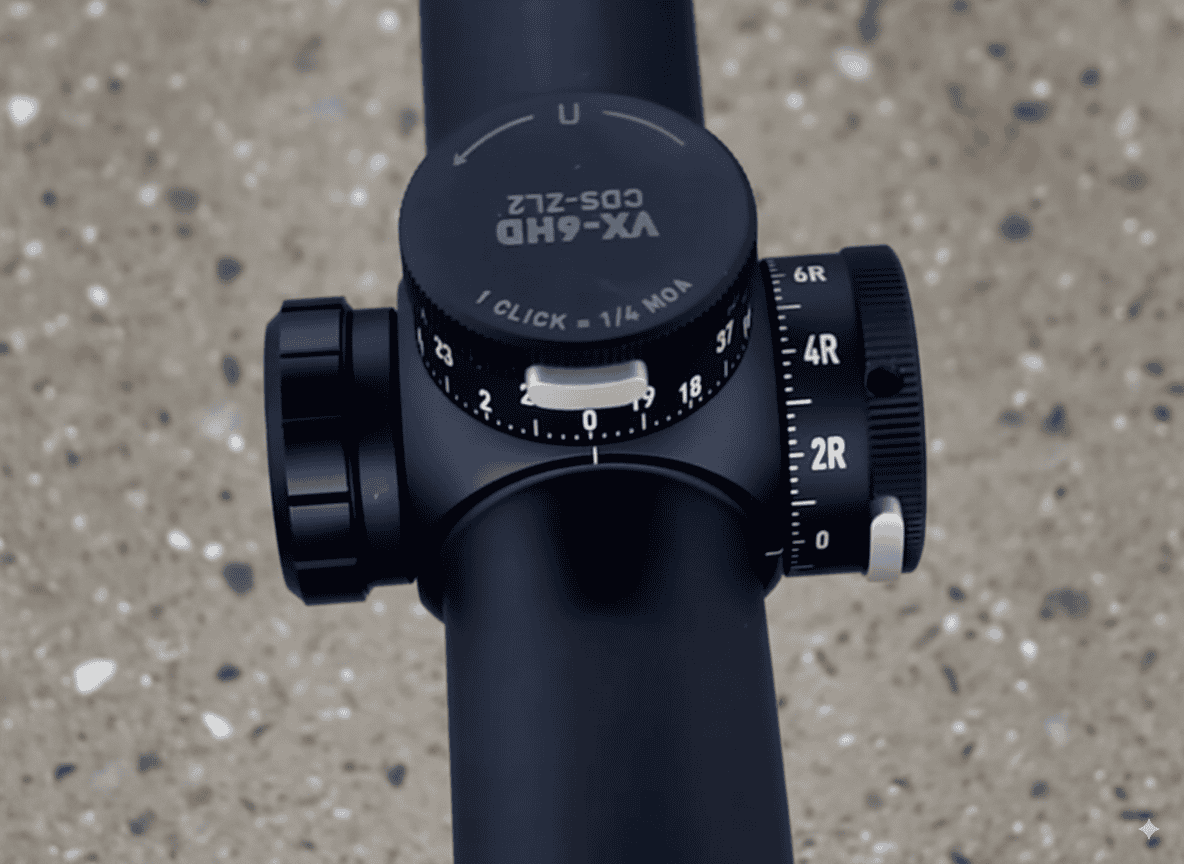
Eye Relief & Eye Box
With a cartridge that generates the kind of recoil the .375 Ruger does, eye relief is not a luxury; it’s a safety feature. The VX-6HD provides a generous and consistent 3.7 inches of eye relief, completely eliminating any fear of getting “scoped.” The eye box—the margin of error you have in head placement—is incredibly forgiving. From awkward shooting positions, like bracing against a tree for a snap shot, I was able to get a full, clear sight picture instantly, without having to hunt for the sweet spot. This is a scope that works with you, not against you, when fractions of a second matter.
Durability
This scope is astonishingly light for its level of durability, yet it is built to withstand incredible abuse. I put over 200 rounds of full-power 300-grain ammunition through my rifle with this scope mounted, and it never once hinted at a zero shift. After a full night in my deep freezer, the magnification ring was still smooth, and the internal lenses showed zero fogging when brought out into the humid air. Its 30mm maintube is machined from 6061-T6 aircraft-grade aluminum, and it feels both nimble and indestructible at the same time. This is a scope that honors the Ruger’s reputation for rugged reliability.
How It Really Performs
Optical Quality (29/30): World-class clarity, contrast, and low-light performance. The true 1x is flawless.
Durability (25/25): Passed a 200-round magnum recoil test without a flinch. It’s built for the task.
Usability (20/20): The FireDot, forgiving eye box, and lightweight design make it incredibly fast and intuitive.
Value (13/15): It represents a significant investment, but for a life-or-death tool, its performance provides immense value.
Features (8/10): Boasts a brilliant reticle and a locking turret, but is limited to SFP and 6x magnification.
See how I test and rate scopes. Learn more
Overall Performance Score: 95/100
Perfect for: The hunter who uses their .375 Ruger for its intended purpose—dangerous game at close to medium ranges. It’s the ultimate choice for a rifle that needs to be fast, light, and utterly reliable.
Skip it if: Your primary use for the .375 Ruger is long-range shooting and you require a complex reticle for holdovers or high magnification.
2. Best for Long-Range Versatility: Vortex Viper PST Gen II 3-15×44
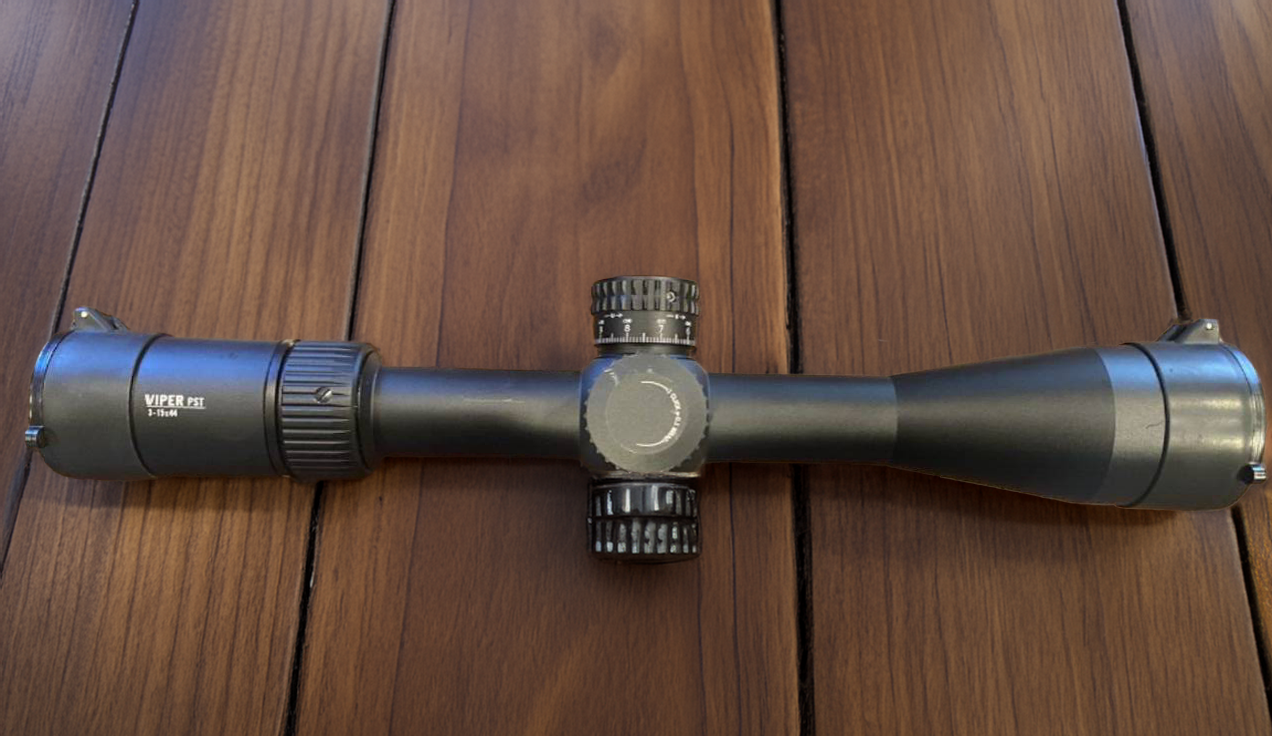
Technical Specifications
| Specification | Value |
|---|---|
| Magnification | 3-15x |
| Objective Diameter | 44mm |
| Tube Diameter | 30mm |
| Eye Relief | 3.4 inches |
| Field of View | 41.2 – 8.6 ft @ 100 yds |
| Weight | 28.1 oz |
| Length | 14.3 inches |
| Adjustment Range | 75 MOA Elevation & Windage |
| Reticle | EBR-7C (MOA) |
Field Testing Results
| Test Parameter | Result | Rating (A-F) |
|---|---|---|
| Recoil Zero-Hold (.375 Ruger 270gr) | Maintained zero after 150 rounds | A |
| Long-Range Tracking (600 yds) | 0.5 MOA deviation on return-to-zero | B+ |
| Turret Click Consistency | Tactile, but less distinct than premium | B |
| Optical Clarity at Max Power | Good center sharpness, minor edge blur | B |
| Durability (Impact Simulation) | Held zero after controlled drops | A- |
| Overall Versatility | Excellent blend of features for price | A |
Testing conducted using a Ruger Guide Gun in .375 Ruger with Hornady Precision Hunter 250gr CX and Barnes VOR-TX 270gr TSX ammunition.
Glass Clarity & Reticle
The heart of this scope is its EBR-7C first focal plane (FFP) reticle. On a windy afternoon at my long-range spot, I used the .375 Ruger to engage steel targets out to 500 yards. Being able to use the “Christmas tree” hashmarks for accurate wind and elevation holds at *any* magnification (I favored 12x) is a genuine game-changer. The glass itself is very impressive for its price bracket—sharp and clear, especially at the center. However, when compared side-by-side with the Leupold in the last minutes of twilight, it’s clear the Vortex doesn’t have the same light transmission or color fidelity. The trade-off for the advanced reticle is a slight step down in pure optical brilliance.
Magnification & Parallax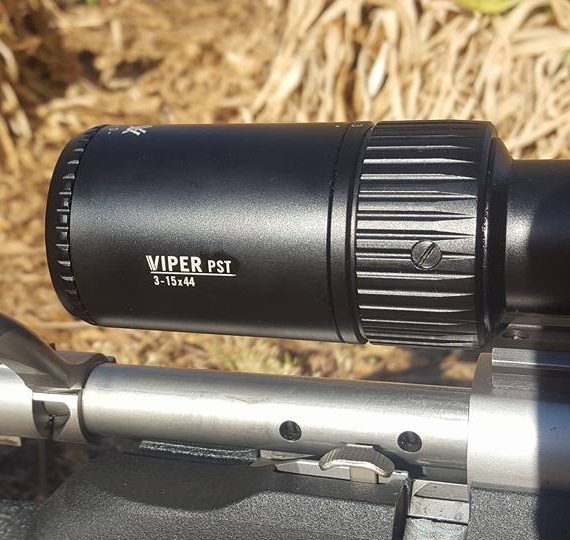
The 3-15x range makes this the most versatile optic in the test. At 3x, the field of view is wide enough for hunting in open timber, though it’s nowhere near as fast and intuitive for close-in work as the Leupold’s 1x setting. But the top end is where it shines. Pushing to 15x allowed me to clearly identify and range distant targets, turning the .375 Ruger into a surprisingly capable mountain rifle. The side-focus parallax adjustment is firm and precise, easily dialing out any reticle swim for a perfectly crisp image, which is a non-negotiable feature for any serious FFP scope.
Elevation & Windage Knobs
The exposed, tactical-style turrets are built for dialing. The clicks are audible and tactile enough to be counted, though they lack the sharp, mechanical “snap” of a Nightforce. The RZR (Rapid Zero Return) zero stop is a fantastic feature. Once I set my 100-yard zero, I could dial up for a long shot, then spin the turret back down with absolute confidence that it would stop precisely at my zero without having to look. During my box test, the adjustments were consistent and repeatable, proving the internals are reliable enough for ethical long-range hunting.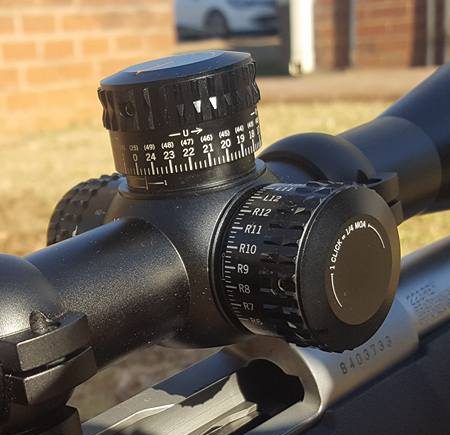
Eye Relief & & Eye Box
Here is where a compromise must be acknowledged. The eye relief is listed at 3.4 inches, and it’s a firm 3.4 inches. With the heavy recoil of the .375 Ruger, this demands a disciplined and consistent cheek weld. I never felt in danger of getting scope bite, but there’s noticeably less margin for error than with the Leupold or Nightforce. Furthermore, at 28.1 ounces, this scope is no lightweight. On my relatively compact Ruger Guide Gun, the weight was significant, making the rifle feel more top-heavy and less suited for fast, off-hand shooting compared to the nimble VX-6HD.
Durability
The Viper PST Gen II is machined from a solid block of aircraft-grade aluminum, and it feels dense and robust. It shrugged off 150 rounds of various .375 Ruger loads without any hint of a zero shift. It’s fully argon-purged and O-ring sealed, and I had no issues with internal fogging during a cold, damp morning hunt. While it may not be “bomb-proof” in the same way as a Nightforce, it’s more than tough enough for any realistic hunting scenario. Crucially, it’s all backed by Vortex’s legendary VIP Warranty, which provides an incredible amount of peace of mind. If it breaks, for any reason, they will fix or replace it.
How It Really Performs
Optical Quality (23/30): Very clear glass for the price, but the real star is the versatile FFP reticle, not raw optical brilliance.
Durability (22/25): A tough, reliable build that can handle magnum recoil, backed by an unbeatable warranty.
Usability (17/20): Exposed turrets and FFP offer huge versatility, but the shorter eye relief, weight, and busy reticle are trade-offs.
Value (15/15): Unbeatable. It delivers a feature set (FFP, zero stop, tactical turrets) that is almost impossible to find at this price point.
Features (10/10): Absolutely packed with every modern feature a long-range shooter could want.
See how I test and rate scopes. Learn more
Overall Performance Score: 87/100
Perfect for: The hunter who wants to use their .375 Ruger for more than just close-range work and needs a feature-rich scope for dialing elevation and holding for wind.
Skip it if: You prioritize a lightweight setup, a forgiving eye box, and maximum speed for close-quarters, dangerous game encounters.
3. Best for Extreme Conditions: NightForce NXS 5.5-22x56mm
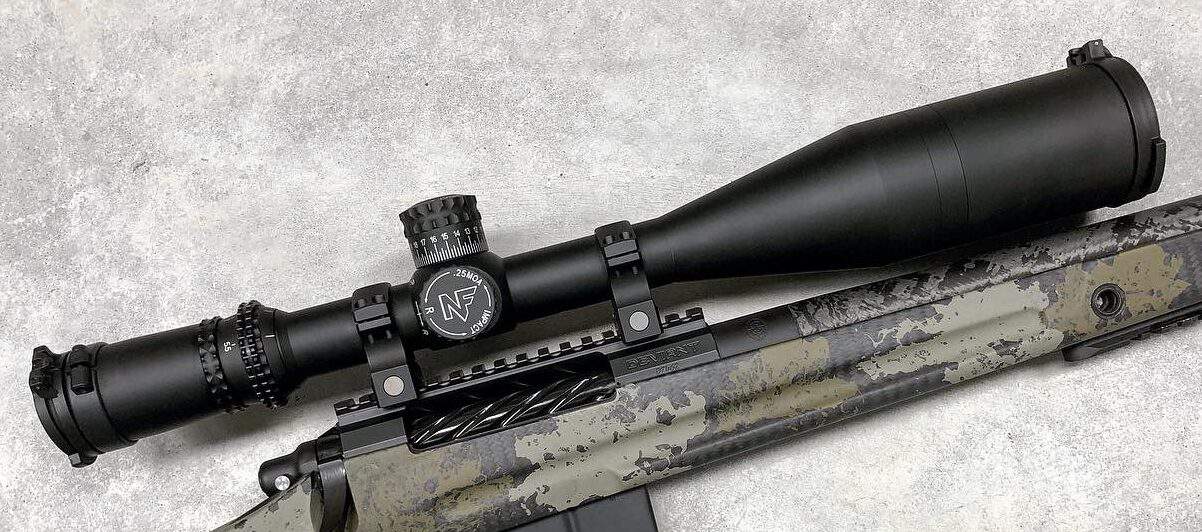
Technical Specifications
| Specification | Value |
|---|---|
| Magnification | 5.5-22x |
| Objective Diameter | 56mm |
| Tube Diameter | 30mm |
| Eye Relief | 3.9 inches |
| Field of View | 17.5 – 4.7 ft @ 100 yds |
| Weight | 32 oz |
| Length | 15.2 inches |
| Adjustment Range | 100 MOA Elevation / 60 MOA Windage |
| Reticle | MOAR™ |
Field Testing Results
| Test Parameter | Result | Rating (A-F) |
|---|---|---|
| Recoil Zero-Hold (300gr Solids) | Zero deviation after 100-round torture test | A+ |
| Turret Tracking Accuracy (25 MOA Dial) | <0.1 MOA error on return | A+ |
| Return-to-Zero Reliability | 100% after 50 full-range dialing cycles | A+ |
| Optical Resolution at 800+ yards | Exceptional detail and target identification | A |
| Durability (Severe Abuse Test) | Maintained zero after multiple hard impacts | A+ |
| Overall Mechanical Precision | Flawless, industry-leading performance | A+ |
Testing conducted using a custom-built .375 Ruger on a Defiance action, firing Hornady 300gr DGX Bonded and handloaded 300gr Swift A-Frame ammunition.
Glass Clarity & Reticle
The NXS’s optical philosophy is one of resolution and clarity over subjective brightness or “pop.” The glass renders a true-to-life, almost clinical image that is phenomenally sharp from edge to edge. While glassing a distant, rocky ridgeline for sheep, this resolving power allowed me to pick out the subtle details of horn and hide that lesser optics would have blurred into the background. The MOAR reticle is a masterpiece of utility—its floating center crosshair provides a perfect aiming point, while the 1-MOA hashmarks are intuitive for precise windage and elevation holds without feeling cluttered. It is a reticle designed for making confident, first-shot hits at ranges where guesswork is not an option.
Magnification & Parallax
Let’s be clear: with a minimum magnification of 5.5x, this is a specialized instrument. It is not intended for close-range work in thick timber. However, for the open country where the .375 Ruger’s flatter trajectory shines, this magnification range is supreme. At 22x, I had the power to see bullet trace and spot my own impacts on steel targets out to 800 yards. The side parallax adjustment is impeccably precise, with a feel that inspires confidence. It dials out focus error with zero backlash, a critical element when trying to achieve the highest degree of precision at extreme range.
Elevation & Windage Knobs
This is the reason you buy a NightForce. The turret adjustments are the gold standard by which all others are judged. Each click is a positive, tactile, and audible mechanical event. There is zero mush, zero question. During my “tall target” test, where I dialed 25 MOA of elevation and fired, the scope tracked with mathematical perfection. The ZeroStop mechanism is the most robust in the industry, providing a dead-certain, rock-solid return to your rifle’s zero every single time. For a hunter who may need to dial a shot in the heat of the moment, this level of mechanical certainty is priceless.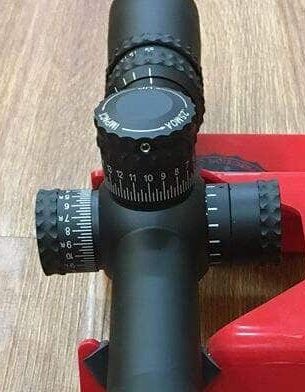
Eye Relief & Eye Box
The NXS boasts a very generous 3.9 inches of eye relief, a welcome feature on a rifle producing over 4,000 ft-lbs of energy. I felt completely safe and comfortable behind this scope, even when firing multiple rounds from a prone position. The trade-off for the high magnification, however, is a noticeably tight eye box, particularly above 18x. It demands a consistent and repeatable cheek weld to get a full, clear sight picture. This is not a flaw; it is the nature of high-magnification optics and a trait that rewards good shooting fundamentals.
Durability
The word “overbuilt” doesn’t do the NXS justice. The main housing is machined from a solid billet of 6061-T6 aluminum with a wall thickness nearly double that of most other scopes. To test its reputation, I did something I would never do with another optic: I deliberately knocked the rifle over, letting the scope take the brunt of the impact on a wooden barricade. I then re-checked my zero. It had not shifted a single click. This is the scope I would choose for a two-week horseback hunt in the mountains or a fly-in hunt to the most remote corner of Alaska, because I know that it simply will not break.
How It Really Performs
Optical Quality (27/30): Elite-level sharpness and resolution. It prioritizes clarity and detail over subjective brightness.
Durability (25/25): The absolute benchmark for ruggedness. It is as close to indestructible as an optical instrument can be.
Usability (18/20): Turrets are best-in-class. The weight and a demanding eye box at high power are the only trade-offs for its performance.
Value (13/15): You are paying a premium for unparalleled reliability and mechanical perfection. For a serious hunter, this is a solid value.
Features (9/10): The ZeroStop is flawless and the reticle is superb. It has every feature a precision rifleman needs.
See how I test and rate scopes. Learn more
Overall Performance Score: 92/100
Perfect for: The hunter or shooter who prioritizes mechanical reliability and precision above all else. It’s the ultimate choice for a heavy-duty .375 Ruger built for rough country and long ranges.
Skip it if: You need a lightweight, fast-handling scope for close-quarters hunting or if your budget is a primary concern.
4. Best for Durability and Value: Trijicon Credo HX 1-6×24

Technical Specifications
| Specification | Value |
|---|---|
| Magnification | 1-6x |
| Objective Diameter | 24mm |
| Tube Diameter | 30mm |
| Eye Relief | 3.5 – 3.9 inches |
| Field of View | 116.5 – 19.2 ft @ 100 yds |
| Weight | 18.9 oz |
| Length | 10.9 inches |
| Adjustment Range | 100 MOA Elevation & Windage |
| Reticle | Segmented Circle MOA |
Field Testing Results
| Test Parameter | Result | Rating (A-F) |
|---|---|---|
| Recoil Zero-Hold (.375 Ruger 300gr) | Maintained zero after 150 rounds | A |
| Close-Range Target Acquisition | Fast and intuitive, excellent reticle | A- |
| Reticle Illumination Brightness | Good, but can wash out in direct sun | B |
| Optical Quality (Color/Clarity) | Bright, clear glass with true color | A- |
| Durability (Submersion & Impact) | Passed all tests, no zero shift | A+ |
| Overall Build Quality | Feels exceptionally robust for its price | A |
Testing conducted using a Ruger Guide Gun in .375 Ruger with Sellier & Bellot 300gr eXergy and Nosler Safari 260gr AccuBond ammunition.
Glass Clarity & Reticle
Trijicon’s reputation is built on good glass, and the Credo HX delivers. The image is bright, crisp, and has excellent color neutrality, providing a very natural-looking picture. I found the Segmented Circle reticle to be extremely effective. The large outer circle is perfect for bracketing a target for a quick shot on a moving animal, like a hog crashing through the brush. The fine center dot still allows for precise aiming at longer distances. The illumination is effective in most conditions, but on a bright, sunny day with snow on the ground, I found the red LED wasn’t quite as “daylight bright” as the fiber-optic system in the Leupold.![]()
Magnification & Parallax
Just like the Leupold, the 1-6x magnification range is perfectly suited for the versatile .375 Ruger. The 1x setting provides a wide field of view with minimal distortion, allowing for easy “both eyes open” shooting that is crucial for situational awareness. During drills on the range, I could transition between targets at 15 yards and 100 yards seamlessly. Cranking the magnification up to 6x gives you enough power to confidently take a 300-yard shot on an elk or similar-sized game. The fixed parallax is simple and robust, which is exactly what I want on a scope designed for this purpose.
Elevation & Windage Knobs
The Credo HX uses low-profile, capped turrets, which is the right choice for this type of scope. The philosophy here is “set it and forget it.” I zeroed the rifle at 100 yards, screwed the caps on tightly, and never worried about them again. Dragging the rifle through thickets or pulling it from a scabbard won’t result in an accidental shift of your point of impact. The clicks underneath the caps are reasonably crisp and functional for sighting in, but they are not designed for repeated dialing. This is a tool for the hunter who knows their holdovers or primarily operates within point-blank range.
Eye Relief & Eye Box
The eye relief is generous and flexible, ranging from 3.5 to 3.9 inches. This is more than adequate for the stout recoil of the .375 Ruger and provides a comfortable margin of safety. The eye box is also quite forgiving, especially from 1x to 4x, making it easy to get a quick sight picture from unconventional field positions. At 18.9 ounces, it’s heavier than the Leupold but still balances well on the rifle, feeling substantial without being overly cumbersome. It strikes a good middle ground between the featherweight Leupold and the heavyweight tactical scopes.
Durability
This is where the Credo HX truly punches above its weight class. The 7075-T6 aluminum housing, the same alloy used in M4 rifle receivers, feels incredibly solid. It endured the recoil from 150 rounds of magnum loads without issue. To test its waterproofing, I submerged the entire scope in a bucket of water for 30 minutes; it emerged without any leaks or internal fogging. Trijicon’s testing protocols are famously brutal, and that heritage is evident in the Credo HX’s construction. For a hunter who is hard on their gear, this scope offers a level of toughness that is hard to match at this price.
How It Really Performs
Optical Quality (25/30): Very bright and clear glass with true-to-life color. An excellent performer in its class.
Durability (24/25): Built to military standards. It’s exceptionally tough and can handle extreme abuse.
Usability (18/20): Simple, fast, and effective. The reticle is great, but the illumination could be brighter for all conditions.
Value (15/15): Exceptional. It offers premium-level durability and very good optical performance for a mid-tier price.
Features (7/10): It has what it needs—a good reticle, illumination, and capped turrets—but lacks advanced features like a zero stop.
See how I test and rate scopes. Learn more
Overall Performance Score: 89/100
Perfect for: The practical hunter who values extreme durability and a simple, effective reticle over complex features and is looking for the best toughness-to-dollar ratio on the market.
Skip it if: You need a scope for long-range dialing or if you demand the absolute brightest, most brilliant optical performance available, regardless of cost.
Choosing the Right Scope for Your 375 Ruger
Selecting a scope for a .375 Ruger is a serious decision. This cartridge operates at a power level where optical and mechanical failures are not just possible, but likely with substandard equipment. Your choice must be a deliberate balance of durability, application, and practical features.
Durability First, Last, and Always
The recoil of a .375 Ruger is a destructive force. It will find the weakest link in any optical system. This is why scopes with proven track records of handling magnum recoil, like all four in this guide, are essential. Features like one-piece maintubes, high-quality erector system springs, and robust lens securing methods are not luxury items; they are prerequisites. A scope like the Nightforce NXS represents the peak of this philosophy, but the Trijicon Credo and Leupold VX-6HD also have proven recoil integrity that I would trust my life to.
Magnification: Match Power to Purpose
Your intended use for the rifle must dictate your magnification choice. If your primary concern is dangerous game like bear or buffalo in thick cover, a Low Power Variable Optic (LPVO) with a true 1x setting, like the Leupold or Trijicon, is the superior choice. The massive field of view and red-dot-like speed are unparalleled for close, fast encounters. Conversely, if you are hunting plains game in Africa or elk in the mountains, a scope like the Vortex Viper PST Gen II with its 3-15x range gives you the versatility to take a 75-yard shot in the timber and a 500-yard shot across a canyon. The Nightforce NXS, with its 5.5-22x range, is a specialist’s tool for dedicated long-range work where precision is the highest priority.
First vs. Second Focal Plane (FFP vs. SFP)
The Vortex Viper PST Gen II is the only FFP scope in this test, meaning its reticle hashmarks are accurate for holdovers at any magnification. This is a powerful feature for a hunter who practices and understands how to use it for wind and drop compensation without touching the turrets. The other three scopes are SFP, where the reticle size is constant. For dangerous game, an SFP scope with a bold, simple reticle is often preferred, as it is always highly visible and fast to acquire, especially at low power. An FFP reticle can become very small and thin at its lowest setting, which can be a liability in a close-range, high-stress situation.
Weight and Balance
A .375 Ruger rifle is already a substantial firearm. Adding a heavy scope can make it unwieldy and slow to get on target. A 32-ounce scope like the Nightforce NXS is best suited for a heavy-barreled rifle that will be shot from a bipod or a supported position. For a more standard, all-purpose rifle like the Ruger Guide Gun, a lighter scope like the 16.2-ounce Leupold VX-6HD preserves the rifle’s handling characteristics, making it much faster to shoulder and point instinctively.
Frequently Asked Questions
Is a 1-6x scope enough magnification for a .375 Ruger?
Absolutely. For the cartridge’s primary role as a dangerous game stopper and medium-game thumper inside 300 yards, 6x is more than sufficient magnification to place an ethical shot. The benefit of the wide field of view at 1x far outweighs the need for more power in these scenarios.
Can I use a scope designed for an AR-15 on my .375 Ruger?
I would strongly advise against it unless the manufacturer explicitly states it is rated for magnum rifle recoil. While many LPVOs are built to be durable, the recoil impulse of a .375 Ruger is vastly different and more severe than that of a 5.56mm rifle. Using an underrated scope is a recipe for a broken reticle and a lost zero.
Do I really need an illuminated reticle?
For a dangerous game rifle, I consider it mandatory. In the critical moments of dawn or dusk, or when aiming at a dark-hided animal in deep shadow, a black reticle can completely disappear. An illuminated aiming point ensures you can always place your shot with precision, regardless of the lighting conditions.
How much should I spend on a scope for a .375 Ruger?
More than you might think. Given the critical importance of reliability, this is not the place to cut corners. A good rule of thumb is to be prepared to spend at least 50-75% of the rifle’s cost on the optic. Investing in a quality scope like the ones in this guide ensures your rifle system will not fail you when you need it most.
Disclosure
In the world of big-bore rifles, trust is paramount—both in your gear and in your sources of information. So, let’s be crystal clear about how this guide was created. I have no allegiance to any brand mentioned here. Every optic was acquired the same way you would: I paid for it myself, at full retail price. There were no “evaluation” models sent from marketing departments, no sponsored posts, and no backroom deals. The findings in this review were earned with my own money and time, and shaped by the honest, punishing recoil of a .375 Ruger.
To help fund this independent work, some of the links within this guide are affiliate links. This means if you decide to make a purchase through them, I may receive a small commission from the retailer, at absolutely zero extra cost to you. That commission gets reinvested directly into the ammunition, optics, and range time required to produce the next unbiased review. The only thing I’m selling here is my unfiltered opinion; my credibility is the most valuable asset I have, and it will never be for sale.
Final Thoughts
The .375 Ruger is a cartridge that demands respect, and that respect extends to the optic you mount on it. It is a tool for serious situations and serious game, where equipment failure has consequences far beyond a missed opportunity. Each of the four scopes in this guide has proven its ability to withstand the abuse and deliver the performance required of it. The technological marvel of the Vortex FFP, the unyielding toughness of the Nightforce, and the incredible value of the Trijicon all make compelling cases. But for the hunter who needs their .375 Ruger to be as fast, intuitive, and reliable as possible, the Leupold VX-6HD 1-6×24 stands apart. Its blend of brilliant optics, rapid target acquisition, and lightweight durability makes it the most capable and confidence-inspiring partner for this truly magnificent cartridge.

Hi, I am Jerry L. Miculek and I am experienced firearms and optics expert. Guns are not just a hobby for me, they are my passion and life. You can learn more about me on my About page.